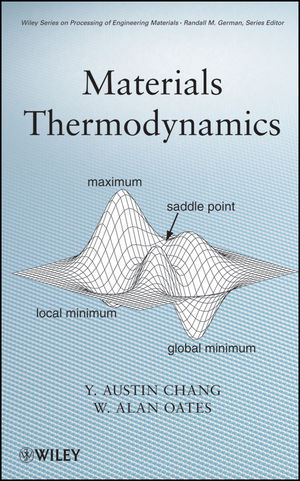Materials ThermodynamicsISBN: 978-0-470-48414-2
Hardcover
320 pages
December 2009
 This is a Print-on-Demand title. It will be printed specifically to fill your order. Please allow an additional 15-20 days delivery time. The book is not returnable.
|
||||||
Quantities, Units, Nomenclature.
1 Review of Fundamentals.
1.1 Systems, Surroundings and Work.
1.2 Thermodynamic Properties.
1.3 The Laws of Thermodynamics.
1.4 The Fundamental Equation.
1.5 Other Thermodynamic Functions.
1.6 Equilibrium State.
Exercises.
2 Thermodynamics of Unary Systems.
2.1 Standard State Properties.
2.2 The Effect of Pressure.
2.3 The Gibbs-Duhem Equation.
2.4 Experimental Methods.
Exercises.
3 Calculation of the Thermodynamic Properties of Unary Systems.
3.1 Constant-Pressure/Constant-Volume Conversions.
3.2 Excitations in Gases.
3.3 Excitations in Pure Solids.
3.4 The Thermodynamic Properties of a Pure Solid.
Exercises.
4 Phase Equilibria in Unary Systems.
4.1 The Thermodynamic Condition for Phase Equilibrium.
4.2 Phase Changes.
4.3 Stability and Critical Phenomena.
4.4 Gibb's Phase Rule.
Exercises.
5 Thermodynamics of Binary Solutions I: Basic Theory and Application to Gas Mixtures.
5.1 Expressing Composition.
5.2 Total (Integral) and Partial Molar Quantities.
5.3 Application to Gas Mixtures.
Exercises.
6 Thermodynamics of Binary Solutions II: Theory and Experimental Methods.
6.1 Ideal Solutions.
6.2 Experimental Methods.
Exercises.
7 Thermodynamics of Binary Solutions III: Experimental Results and Their Analytical Representation.
7.1 Some Experimental Results.
7.2 Analytical Representation of Results for Liquid or Solid Solutions.
Exercises.
8 Two-Phase Equilibrium I: Theory.
8.1 Introduction.
8.2 Criterion for Phase Equilibrium Between Two Specified Phases.
8.3 Gibb's Phase Rule.
Exercises.
9 Two-Phase Equilibrium II: Example Calculations.
Exercises.
10 Binary Phase Diagrams: Temperature-Composition Diagrams.
10.1 True Phase Diagrams.
10.2 T-xi Phase Diagrams for Strictly Regular Solutions.
10.3 Polymorphism.
Exercises.
11 Binary Phase Diagrams: Temperature-Chemical Potential Diagrams.
11.1 Some General Points.
Exercises.
12 Phase Diagram Topology.
12.1 Gibbs's Phase Rule.
12.2 Combinatorial Analysis.
12.3 Schreinemaker’s Rules.
12.4 The Gibbs-Konovalov Equations.
Exercises.
13 Solution Phase Models I: Configurational Entropies.
13.1 Substitutional Solutions.
13.2 Intermediate Phases.
13.3 Interstitial Solutions.
Exercises.
14 Solution Phase Models II: The Configurational Energy.
14.1 Pair Interaction Model.
14.2 Cluster Model.
Exercises.
15 Solution Models III: The Configurational Free Energy.
15.1 Helmholtz Energy Minimization.
15.2 Critical Temperature for Order/Disorder.
Exercises.
16 Solution Models IV: The Total Gibbs Energy.
16.1 Atomic Size Mismatch Contributions.
16.2 Contributions from Thermal Excitations.
16.3 The Total Gibbs Energy in Empirical Model Calculations.
Exercises.
17 Chemical Equilibria I: Single Chemical Reaction Equations.
17.1 Introduction.
17.2 The Empirical Equilibrium Constant.
17.3 The Standard Equilibrium Constant.
17.4 Calculating the Equilibrium Position.
17.5 Application of the Phase Rule.
Exercises.
18 Chemical Equilibria II: Complex Gas Equilibria.
18.1 The Importance of System Definition.
18.2 Calculation of Chemical Equilibrium.
18.3 Evaluation of Elemental Chemical Potentials in Complex Gas Mixtures.
18.4 Application of the Phase Rule.
Exercises.
19 Chemical Equilibria Between Gaseous and Condensed Phases I.
19.1 Graphical Presentation of Standard Thermochemical Data.
19.2 Ellingham Diagrams.
Exercises.
20 Chemical Equilibria Between Gaseous and Condensed Phases II.
20.1 Subsidiary Scales on Ellingham Diagrams.
20.2 System Definition.
Exercises.
21 Thermodynamics of Ternary Systems.
21.1 Analytical Representation of Thermodynamic Properties.
21.2 Phase Equilibria.
Exercises.
22 Generalized Phase Diagrams for Ternary Systems.
22.1 System Definition.
Exercises.
Appendix A: Some Linearized Standard Gibbs Energies of Formation.
Appendix B: Some Useful Calculus.
Index.



